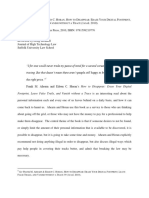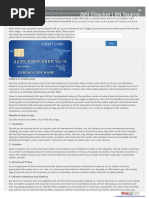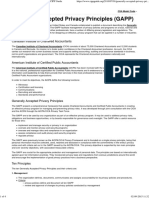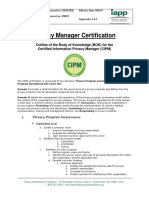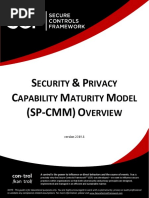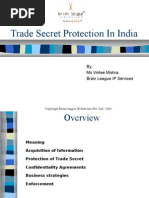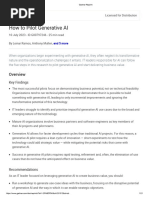Cippit Bok
Cippit Bok
Uploaded by
Susie BinuCopyright:
Available Formats
Cippit Bok
Cippit Bok
Uploaded by
Susie BinuOriginal Title
Copyright
Available Formats
Share this document
Did you find this document useful?
Is this content inappropriate?
Copyright:
Available Formats
Cippit Bok
Cippit Bok
Uploaded by
Susie BinuCopyright:
Available Formats
copyright 2011, IAPP
IT Privacy Certification
Outline of the Common Body of Knowledge (CBK) for The Certified Information Privacy Professional/Information Technology (CIPP/IT)
I.
System Activities that Impact End User Privacy
A. The Information Lifecycle a. Manual processes i. Interaction ii. Data entry Systems i. Operating and file ii. Database iii. Applications iv. Network and data transport v. Web services vi. Client services Data types i. Personally identifiable information (PII) ii. Regulated information (SOX, HIPAA) iii. Credit card information iv. Trade secrets (organization) v. Contractual information (partners, customers)
b.
c.
B. The IT Development Lifecycle a. Privacy i. ii. iii. iv. v. intersections in the development process Release planning Definition Development Validation Deployment
Pease International Tradeport 75 Rochester Avenue. Suite 4 Portsmouth, NH 03801 USA + 603.427.9200 certification@privacyassociation.org
copyright 2011, IAPP
C. Data collection and transfer a. b. Responsibilities of the IT professional Determining data accountability i. Ownership of data ii. Data inventory iii. Degree of data sensitivity Purpose and uses of PII i. PCI regulated data Employee data uses Onward transfers of data i. External parties ii. Storage/transfer media iii. Routine and non-routine transfers Employee data challenges i. Locations and modes ii. Business use of mobile services
c. d. e.
f.
D. Data Security a. Top 20 i. ii. iii. iv. v. Credit i. ii. security risks (SANS) Client-side Server-side Security policy and personnel Application 1. SQL injection Network card information Cardholder data types Application of Payment Card Industry Data Security Standards (PCI DSS)
b.
E.
Data Storage a. Types of storage i. Persistent ii. Transient Location of storage i. Systems ii. Location
b.
F.
Data Processing a. b. Internal processing i. Primary and secondary uses Relationships with third parties i. Global resourcing and outsourcing ii. Vendor management
G. Data Retention and Destruction a. b. c. Period of retention Duplication of records Consistency of policy and practice
Pease International Tradeport 75 Rochester Avenue. Suite 4 Portsmouth, NH 03801 USA + 603.427.9200 certification@privacyassociation.org
copyright 2011, IAPP
H. Data Access and redress a. b. c. d. I. Legal requirements Business rationale Access mechanisms Handling requests
Privacy and System Design a. Applying Fair Information Practice principles i. Collection limitation ii. Data quality iii. Purpose specification iv. Use limitation v. Security safeguards vi. Openness vii. Individual participation viii. Accountability
II.
Data Subject Privacy Expectations and Behaviors
A. Privacy Expectations a. b. The consumer perspective Organizational practices
B. Privacy Responsibility Framework a. b. c. d. User sphere Joint sphere Recipient sphere Engineering issues and responsibilities
C. E-commerce Personalization a. b. End user benefits End user privacy concerns i. Unsolicited marketing ii. Inaccurate inferences iii. Price discrimination iv. Unauthorized account access or data sharing
D. System Monitoring a. Phone-home software
Pease International Tradeport 75 Rochester Avenue. Suite 4 Portsmouth, NH 03801 USA + 603.427.9200 certification@privacyassociation.org
copyright 2011, IAPP
III.
Privacy Protection Mechanisms
A. Privacy by Architecture a. b. c. d. e. f. Addressing data protection gaps Separating profile and transaction data Granularity levels for data collection Limiting common attributes and identifiers Regular or forced deletion of profile data Decentralized privacy architecture
B. Privacy by policy a. b. c. d. Notice and choice Security safeguards Access Accountability i. Audits
C. Identifiability a. b. c. d. Labels that point to individuals Strong and weak identifiers Pseudonymous and anonymous data Degrees of identifiability i. Definition under the EU Directive ii. Privacy stages and system characteristics 1. Identifiable versus identified 2. Linkable versus linked
D. Privacy-enhancing Techniques a. Web security protocols i. Transport Security Layer (TLS) ii. Secure Sockets Layer (SSL) iii. Hypertext Transfer Protocol-Secure (HTTPS) Automated data retrieval Automated system audits Data masking and data obfuscation Data encryption i. Cryptography 1. Crypto design and implementation considerations 2. Application or field encryption 3. File encryption 4. Disk encryption
b. c. d. e.
Pease International Tradeport 75 Rochester Avenue. Suite 4 Portsmouth, NH 03801 USA + 603.427.9200 certification@privacyassociation.org
copyright 2011, IAPP
E.
Privacy-enhancing Tools a. b. c. Limiting or preventing automated data capture Combating threats and exploits Anonymity tools i. Anonymizers ii. Privacy-preserving data mining iii. Applications of anonymity tools 1. Communication and publishing 2. Payment processing 3. Voting and surveying 4. Credentialing 5. Anonymity by Web proxy a. The Tor Anonymity System
IV.
Providing Notice and Choice
A. Types of notice and choice a. b. c. Policy components Means of distribution Explicit and implicit consent
B. Software-based notice and consent a. b. c. Guidelines End user license agreement (EULA) Mechanisms i. Out-of-box ii. Installation time iii. First-run iv. Just-in-time v. Collections and/or transfers of data vi. Online services 1. Redirecting Internet searches and queries 2. Modifying Web browser settings 3. Activating a feature function with system impact 4. Online advertising 5. Software updates 6. Software removal 7. Location-based services vii. Machine-readable privacy policy languages 1. Platform for Privacy Preferences Project (P3P) a. User agents b. Policy assertions c. Deployment 2. Application Preference Exchange Language (APPEL) 3. Enterprise Privacy Authorization Language (EPAL)
Pease International Tradeport 75 Rochester Avenue. Suite 4 Portsmouth, NH 03801 USA + 603.427.9200 certification@privacyassociation.org
copyright 2011, IAPP
V.
Auditing and Enforcing IT Privacy Compliance
A. Data Governance a. Management, control and evaluation frameworks i. ISO/IEC 38500:2008 ii. Control Objectives for Information and Related Technology (COBIT) IT service management frameworks i. Information Technology Infrastructure Library (ITIL) ii. IBM Tivoli Unified Process (ITUP) Industry consortia security frameworks i. Payment Card Industry Data Security Standards (PCI DSS) ii. Health Information Trust Alliance (HITRUST) Security risk and compliance review (SRCR)
b.
c.
d.
B. Audits in the Context of Privacy a. b. Defining the audit Understanding the range of options i. Gap assessments (risk) ii. Legal reviews (compliance) iii. Attestation (third party) Generally Accepted Privacy Principles (GAPP) framework Role of the IT auditor i. Privacy impact assessments (PIA) ii. Control objectives iii. Evidence and documentation iv. Testing and verification IT internal audit i. Working with legal and compliance partners
c. d.
e.
VI.
Implementing Technologies with Privacy Impacts
A. Software as a Service (SaaS) a. Cloud Computing Platforms i. Location considerations ii. Impacts on privacy obligations and protections iii. Legal uncertainty
B. Wireless IDs a. b. Radio Frequency Identification (RFID) Bluetooth devices
C. Location-based services a. b. Global Positioning Systems (GPS) Geographic Information Systems (GIS)
Pease International Tradeport 75 Rochester Avenue. Suite 4 Portsmouth, NH 03801 USA + 603.427.9200 certification@privacyassociation.org
copyright 2011, IAPP
D. Identity and Access Management (IAM) a. b. c. Role-based access control (RBAC) User-based access controls Context of authority i. User to site ii. User to enterprise 1. Multiple enterprises Cross-enterprise authentication and authorization models i. Liberty Alliance Project ii. Open ID Federation iii. Identity Metasystem Architecture
d.
E.
Business Intelligence and Analytics a. b. c. Applications Demand among businesses and governments Risks
Pease International Tradeport 75 Rochester Avenue. Suite 4 Portsmouth, NH 03801 USA + 603.427.9200 certification@privacyassociation.org
You might also like
- Microsoft Word KYC Application Form - doc.PDF IndividualDocument1 pageMicrosoft Word KYC Application Form - doc.PDF Individualseth33% (3)
- CIPT Questions Without AnswerDocument102 pagesCIPT Questions Without AnswerMusa Odole SolomonNo ratings yet
- BSBOPS505 - Project Portfolio.v1.0Document31 pagesBSBOPS505 - Project Portfolio.v1.0Jaydeep Kushwaha100% (7)
- How To Disappear Erase Your Digital Footprint Leave False Trails and Vanish Without A TraceDocument5 pagesHow To Disappear Erase Your Digital Footprint Leave False Trails and Vanish Without A Tracereaper0belial0No ratings yet
- CIPPE FSG November - 2018 - v1Document14 pagesCIPPE FSG November - 2018 - v1eyall8855No ratings yet
- General Global Consent FormDocument2 pagesGeneral Global Consent Formbc210411250 BISMA BIBINo ratings yet
- Bin Checker GuideDocument6 pagesBin Checker Guidebinchecker83% (6)
- Listening - Listen To Restaurant Conversations - Modo - Informe - Unit 4 - Lesson 3 - %coursename% - MyEnglishLab PDFDocument1 pageListening - Listen To Restaurant Conversations - Modo - Informe - Unit 4 - Lesson 3 - %coursename% - MyEnglishLab PDFangelo75% (4)
- 1.4 PrivacyDocument23 pages1.4 PrivacyManoj SharmaNo ratings yet
- General Data Protection Law: Important Points Regarding GDPRDocument4 pagesGeneral Data Protection Law: Important Points Regarding GDPRRavi KumarNo ratings yet
- Belgian DPA Registry of Processing Activities Template 20170907 enDocument71 pagesBelgian DPA Registry of Processing Activities Template 20170907 enNicola Fiori100% (1)
- GDPR Compliance ChecklistDocument6 pagesGDPR Compliance ChecklistZeeshan RanaNo ratings yet
- European Privacy CertificationDocument4 pagesEuropean Privacy CertificationadnanjavNo ratings yet
- Privacy Manager CertificationDocument7 pagesPrivacy Manager CertificationroruangNo ratings yet
- CIPP A Authoritative Resource List 4.0Document3 pagesCIPP A Authoritative Resource List 4.0Anjali BhaskarNo ratings yet
- Privacy Manager Certification: Examination Blueprint For The Certified Information Privacy Manager (CIPM)Document2 pagesPrivacy Manager Certification: Examination Blueprint For The Certified Information Privacy Manager (CIPM)MatthewNo ratings yet
- 2018 Data Privacy and GDPR ReportDocument14 pages2018 Data Privacy and GDPR ReportDemand MetricNo ratings yet
- Metomic GDPR Summary - FinanceDocument19 pagesMetomic GDPR Summary - FinanceHaroun HickmanNo ratings yet
- CIPM Exam_Page 6 _ ExamTopicsDocument10 pagesCIPM Exam_Page 6 _ ExamTopicskayleesocoolNo ratings yet
- All About The NIST Privacy Framework - OneTrust BlogDocument3 pagesAll About The NIST Privacy Framework - OneTrust BlogNicholasFCheongNo ratings yet
- Panel 3 PPT - Preparing For The GDPRDocument21 pagesPanel 3 PPT - Preparing For The GDPRgschandel3356No ratings yet
- Check or Mate?: Strategic Privacy by DesignDocument12 pagesCheck or Mate?: Strategic Privacy by DesignPedro HenriqueNo ratings yet
- Cipt 1 PDFDocument384 pagesCipt 1 PDFVIMAL KUMAR CHAUHANNo ratings yet
- NOREA Privacy Control Framework v1.0Document68 pagesNOREA Privacy Control Framework v1.0saf100% (1)
- Certified Information Privacy Manager A Complete Guide - 2020 EditionFrom EverandCertified Information Privacy Manager A Complete Guide - 2020 EditionNo ratings yet
- Preparing For The New EU GDPR Compliance - Webinar From TRUSTeDocument29 pagesPreparing For The New EU GDPR Compliance - Webinar From TRUSTeTrustArc100% (1)
- Certified Information Privacy Technologist A Complete GuideFrom EverandCertified Information Privacy Technologist A Complete GuideNo ratings yet
- Generally Accepted Privacy Principles (GAPP) CIPP GuideDocument4 pagesGenerally Accepted Privacy Principles (GAPP) CIPP GuidehardyNo ratings yet
- CRISC BrochureDocument2 pagesCRISC BrochureSpipparisNo ratings yet
- GDPR CdpoDocument11 pagesGDPR CdpoLenny SyarlithaNo ratings yet
- General Data Protection Regulation: Data Subject Rights Breach NotificationDocument3 pagesGeneral Data Protection Regulation: Data Subject Rights Breach Notificationsidey saxenaNo ratings yet
- Engineering Privacy by Design Are Engineers Ready To Live Up To The Challenge2019information Society PDFDocument22 pagesEngineering Privacy by Design Are Engineers Ready To Live Up To The Challenge2019information Society PDFMoises Neves Camelo100% (1)
- GDPR - Skillcast Presentation TemplateDocument23 pagesGDPR - Skillcast Presentation TemplatenipundaNo ratings yet
- Data Privacy Periodic TableDocument1 pageData Privacy Periodic TableHerdade, Martini de CamposNo ratings yet
- Designing GDPR Data Protection Principles in Systems DevelopmentDocument8 pagesDesigning GDPR Data Protection Principles in Systems DevelopmentIgor MagalhãesNo ratings yet
- Cipt 642-444Document40 pagesCipt 642-444Hashimmurikkad ShaNo ratings yet
- Defradar - Supplier GDPR Assessment ProcedureDocument6 pagesDefradar - Supplier GDPR Assessment ProcedureJakobović DomagojNo ratings yet
- Global Ai Legislation TrackerDocument16 pagesGlobal Ai Legislation TrackershujatheblackbloodNo ratings yet
- IAPP Cipm - Instructiuni Tematica Si ExamenDocument7 pagesIAPP Cipm - Instructiuni Tematica Si ExameneuromarketNo ratings yet
- DPO As A Service FinalDocument15 pagesDPO As A Service FinalimatacheNo ratings yet
- GDPR Cloud Computing Guidelines enDocument53 pagesGDPR Cloud Computing Guidelines enJack DanieldsNo ratings yet
- Summary of The HIPAA Security RuleDocument7 pagesSummary of The HIPAA Security RuleSundevil LeeNo ratings yet
- GDPR Consent To Collect Data From European Union Students PDFDocument2 pagesGDPR Consent To Collect Data From European Union Students PDFYurica CossaNo ratings yet
- Should The DPO Be CertifiedDocument14 pagesShould The DPO Be CertifiedKoen VerbekeNo ratings yet
- Prepare For GDPR Today With Microsoft 365Document16 pagesPrepare For GDPR Today With Microsoft 365Imperial ArnelNo ratings yet
- Practical GDPR GuideDocument10 pagesPractical GDPR GuideRaghavendra KamurthiNo ratings yet
- European General Data Protection Regulation (GDPR) : Territorial ScopeDocument1 pageEuropean General Data Protection Regulation (GDPR) : Territorial Scopelyndon_baker_1No ratings yet
- How-to-Audit-GDPR WHP Eng 1018 PDFDocument17 pagesHow-to-Audit-GDPR WHP Eng 1018 PDFHost MomNo ratings yet
- 7.4 - Defradar - GDPR Preparation Project PlanDocument1 page7.4 - Defradar - GDPR Preparation Project PlanJakobović DomagojNo ratings yet
- CIPP_Exam_Preparation_Tips_1725949523Document29 pagesCIPP_Exam_Preparation_Tips_1725949523Lance AdamsNo ratings yet
- Privacy Enhancing Technologies 1 0Document66 pagesPrivacy Enhancing Technologies 1 0Coskun OzelNo ratings yet
- Global Comprehensive Privacy Law MappingDocument6 pagesGlobal Comprehensive Privacy Law MappingSridhaar Dara100% (1)
- 2023 2030 Australian Cyber Security Action Plan 1701049194Document28 pages2023 2030 Australian Cyber Security Action Plan 1701049194hello.esolutionerNo ratings yet
- Checklist For Data Protection Officer (DPO) : Within 30 DaysDocument2 pagesChecklist For Data Protection Officer (DPO) : Within 30 DaysFe TafallaNo ratings yet
- SCF Security & Privacy Capability Maturity Model OverviewDocument14 pagesSCF Security & Privacy Capability Maturity Model OverviewGerardo Castro100% (1)
- DPDP NoteDocument14 pagesDPDP NoteTejas KadamNo ratings yet
- GDPR QuestionnaireDocument3 pagesGDPR QuestionnaireLeopoldo DelgadoNo ratings yet
- DT MT Risk Understanding GDPRDocument32 pagesDT MT Risk Understanding GDPRBogdan ArseneNo ratings yet
- General Data Protection Regulation (GDPR)Document14 pagesGeneral Data Protection Regulation (GDPR)Arushi JohriNo ratings yet
- Rashal International LLC GDPR Compliance Extract (International)Document5 pagesRashal International LLC GDPR Compliance Extract (International)Rashal International LLCNo ratings yet
- Consent Expert Handbook v20230814Document53 pagesConsent Expert Handbook v20230814radhika8512No ratings yet
- Powering Privacy Compliance and Risk Management - TrustArcDocument1 pagePowering Privacy Compliance and Risk Management - TrustArcTrustArcNo ratings yet
- Six Ways: Privacy Awarenesstraining Will Transform Your StaffDocument4 pagesSix Ways: Privacy Awarenesstraining Will Transform Your StaffSoke AndreiNo ratings yet
- Feed Essay (Power and Manipulation)Document5 pagesFeed Essay (Power and Manipulation)api-253776299100% (1)
- Role of CryptographyDocument23 pagesRole of Cryptographysushanta.ww9No ratings yet
- What Is A Privacy Policy?Document3 pagesWhat Is A Privacy Policy?Kavya GopakumarNo ratings yet
- Trade Secret Protection in IndiaDocument22 pagesTrade Secret Protection in IndiacnathapolNo ratings yet
- Virginia Tech Shootings - Complete Report of The Governor's Review PanelDocument260 pagesVirginia Tech Shootings - Complete Report of The Governor's Review Panelpolitix100% (3)
- Gartner ReprintDocument21 pagesGartner Reprintsw21910No ratings yet
- Critique by Atty. Cristina A. Montes of The UP Primer On Legal Issues On Reproductive Rights - Constitutional Law IssuesDocument9 pagesCritique by Atty. Cristina A. Montes of The UP Primer On Legal Issues On Reproductive Rights - Constitutional Law IssuesCarlos Antonio P. PaladNo ratings yet
- Example Cases For Code of Ethics With SolutionDocument12 pagesExample Cases For Code of Ethics With SolutionHussain67% (3)
- Instant Ebooks Textbook (Ebook PDF) Canadian Business Law Today Canadian Edition by Nancy Breen Download All ChaptersDocument41 pagesInstant Ebooks Textbook (Ebook PDF) Canadian Business Law Today Canadian Edition by Nancy Breen Download All Chaptersiwokdeyu100% (5)
- Contextualizing Current Digital Religion Research On Emerging TechnologiesDocument7 pagesContextualizing Current Digital Religion Research On Emerging TechnologiesMaulidaNo ratings yet
- S Y B Tech 2023-Pattern-NEP-Sem-IDocument29 pagesS Y B Tech 2023-Pattern-NEP-Sem-Ikishor bholeNo ratings yet
- 1 s2.0 S0167404822002978 MainDocument23 pages1 s2.0 S0167404822002978 MainBENTRIA maamarNo ratings yet
- P1-12-PASCAL (MALLORCA GROUP) Social Media and Its Perceived Effects To Students Academic PerformanceDocument26 pagesP1-12-PASCAL (MALLORCA GROUP) Social Media and Its Perceived Effects To Students Academic PerformanceJohn Cyril Mallorca100% (2)
- Adobe Scan Dec 29, 2021Document1 pageAdobe Scan Dec 29, 2021Raju kumar choudharyNo ratings yet
- TESDA Circular No. 016 2022 Implementing Guidelines On The Use of The BSRS in The Training ProgramDocument10 pagesTESDA Circular No. 016 2022 Implementing Guidelines On The Use of The BSRS in The Training ProgramEpisode 17No ratings yet
- Terms and ConditionsDocument29 pagesTerms and Conditionsbalkrushnagutte5No ratings yet
- CSF ReviewPanDocument1 pageCSF ReviewPanSunny Prasad ShawNo ratings yet
- Descriptive TextDocument13 pagesDescriptive Texttsaniya faraNo ratings yet
- BAFEDM FinalJul 102019Document35 pagesBAFEDM FinalJul 102019venus camposanoNo ratings yet
- Rakso Booking TermsDocument2 pagesRakso Booking TermsPat Buslon - Geronimo100% (1)
- Scammed: Defend Against Social EngineeringDocument31 pagesScammed: Defend Against Social EngineeringMitesh PatelNo ratings yet
- Customer's Perception Towards Cashless Transaction and Information Security in The Digital EconomyDocument66 pagesCustomer's Perception Towards Cashless Transaction and Information Security in The Digital EconomyPriyanshi PatelNo ratings yet
- Admin Quasi Legislativequasi JudicialDocument34 pagesAdmin Quasi Legislativequasi JudicialAnonymous uMI5BmNo ratings yet
- Villalobos Ethics Argument EssayDocument10 pagesVillalobos Ethics Argument Essayapi-727275001No ratings yet



